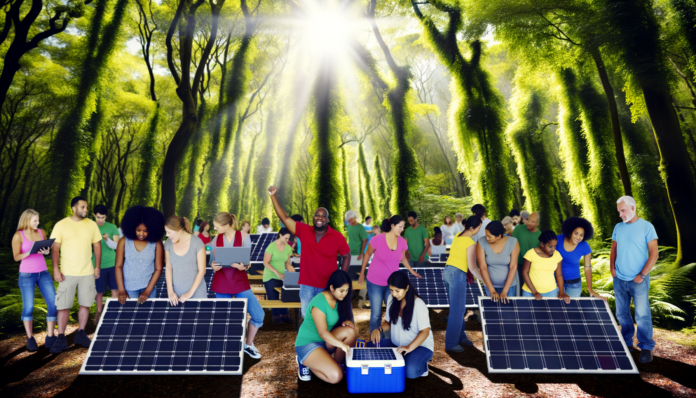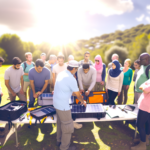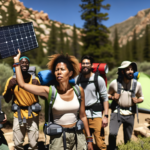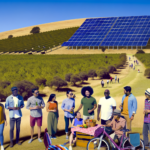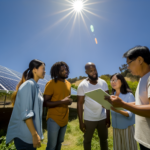Introduction
The Growing Popularity of Solar Power in Outdoor Adventures
In recent years, the use of solar power in outdoor adventures has seen a significant surge. As more people seek to escape the hustle and bustle of urban life, they are turning to nature for solace and adventure. This shift has brought about a growing awareness of the need for sustainable and reliable energy sources in the wild. Solar power, with its renewable and eco-friendly attributes, has become the go-to solution for many outdoor enthusiasts. Whether it’s for charging devices, powering portable fridges, or even running small appliances, solar energy is proving to be an invaluable resource for those who love to explore the great outdoors.
Why Solar Skills are Essential for the Adventurous Spirit
For the adventurous spirit, mastering solar skills is not just a matter of convenience; it’s a necessity. The ability to harness solar power can mean the difference between a successful adventure and a dire situation. Imagine being deep in the wilderness with a dead GPS or an uncharged satellite phone. Knowing how to set up and maintain a portable solar system can provide the peace of mind that comes with being prepared for any situation. Moreover, understanding solar power allows adventurers to minimize their environmental impact, aligning their love for nature with sustainable practices. As Jeff Longshore, an alum of the “Nothing Course,” eloquently put it, “I gained knowledge, comfort, understanding, and peace with myself in not only the wilderness but the unknown of the world that we live in today.”
Overview of the Article
This article aims to equip outdoor enthusiasts with the knowledge and skills needed to effectively use solar power in their adventures. We will begin by exploring the basics of solar power, including how it works, the different types of solar panels available, and the benefits of using solar energy in the wild. Next, we will delve into essential solar skills, such as setting up a portable solar system, maintaining and troubleshooting equipment, and maximizing solar efficiency in various environments.
Following this, we will provide an overview of workshops and training programs designed to teach these vital skills. These workshops offer hands-on training and online resources to ensure that adventurers are well-prepared. We will also share inspiring case studies of individuals who have successfully integrated solar power into their outdoor experiences, highlighting the lessons they have learned and the tips they offer.
Finally, we will look at future trends in solar technology and how these innovations will further enhance outdoor adventures. The article will conclude with a recap of key points, encouragement to pursue solar skills, and final thoughts on the importance of sustainability in adventure.
By the end of this article, readers will have a comprehensive understanding of how to harness solar power for their outdoor adventures, ensuring they are well-equipped to explore the wild responsibly and sustainably.
Understanding Solar Power Basics
How Solar Power Works
Solar power harnesses energy from the sun and converts it into electricity using photovoltaic (PV) cells. These cells are typically made from silicon and are arranged in panels. When sunlight hits the PV cells, it excites electrons, creating an electric current. This direct current (DC) is then converted into alternating current (AC) by an inverter, making it usable for most electrical devices. The entire process is clean, renewable, and increasingly efficient, making it an ideal power source for outdoor adventures.
Types of Solar Panels and Their Uses
There are several types of solar panels, each with its own advantages and applications:
- Monocrystalline Panels: These are made from a single crystal structure, offering high efficiency and durability. They are ideal for long-term outdoor use where space is limited.
- Polycrystalline Panels: Made from multiple silicon crystals, these panels are slightly less efficient but more cost-effective. They are suitable for larger setups where space is not a constraint.
- Thin-Film Panels: These are lightweight and flexible, making them perfect for portable applications like hiking and camping. However, they are generally less efficient than crystalline panels.
- Portable Solar Chargers: These are small, lightweight panels designed to charge devices like smartphones, GPS units, and cameras. They are essential for short trips and emergency situations.
Benefits of Using Solar Power in the Wild
Using solar power in outdoor settings offers numerous benefits:
- Renewable and Sustainable: Solar energy is a renewable resource, reducing the need for fossil fuels and minimizing environmental impact.
- Cost-Effective: After the initial investment, solar power is free. It eliminates the need for disposable batteries and reduces the cost of fuel for generators.
- Portability: Modern solar panels are lightweight and easy to transport, making them ideal for backpacking, camping, and other outdoor activities.
- Reliability: Solar panels can provide power in remote locations where traditional power sources are unavailable. They are particularly useful for emergency situations.
- Quiet Operation: Unlike generators, solar panels operate silently, preserving the tranquility of nature.
In summary, understanding the basics of solar power, the types of solar panels available, and the benefits they offer can significantly enhance your outdoor adventures. Whether you’re setting up a base camp or embarking on a multi-day trek, solar power provides a reliable, sustainable, and efficient energy solution.
Essential Solar Skills for Outdoor Enthusiasts
Setting Up a Portable Solar System
Setting up a portable solar system is a fundamental skill for any outdoor enthusiast looking to harness the power of the sun. The first step is to choose the right solar panel. **Monocrystalline panels** are highly efficient and compact, making them ideal for backpacking and camping. **Polycrystalline panels** are less expensive but slightly less efficient, suitable for larger setups like base camps.
Once you have your solar panel, you’ll need a **solar charge controller** to regulate the voltage and current coming from the panels to the battery. This prevents overcharging and extends the life of your battery. Next, select a **deep-cycle battery** to store the energy. Lithium-ion batteries are lightweight and have a longer lifespan compared to lead-acid batteries.
Finally, you’ll need an **inverter** to convert the stored DC power into AC power, which can be used to charge your devices. Setting up involves connecting the solar panel to the charge controller, the charge controller to the battery, and the battery to the inverter. Always ensure that all connections are secure and weatherproof to avoid any malfunctions.
Maintaining and Troubleshooting Solar Equipment
Maintaining your solar equipment is crucial for its longevity and efficiency. Regularly clean the solar panels with a soft cloth and water to remove dust and debris that can block sunlight. Inspect the wiring and connections for any signs of wear or corrosion, and replace any damaged components immediately.
**Battery maintenance** is equally important. For lithium-ion batteries, ensure they are not exposed to extreme temperatures and avoid completely discharging them. For lead-acid batteries, check the electrolyte levels and top up with distilled water if necessary.
Troubleshooting common issues involves a few basic steps. If your system isn’t generating power, check the solar panel for shading or dirt. Verify that all connections are secure and that the charge controller is functioning correctly. Use a multimeter to check the voltage output from the solar panel and the battery. If the readings are lower than expected, it might indicate a faulty panel or battery.
Maximizing Solar Efficiency in Different Environments
Maximizing solar efficiency requires understanding how different environments affect solar power generation. In **sunny and open areas**, position your solar panels at an angle that captures the most sunlight throughout the day. A general rule is to tilt the panel at an angle equal to your latitude for optimal year-round performance.
In **forested or shaded areas**, finding a spot with the least amount of shade is crucial. You may need to move your panels throughout the day to follow the sun. Using a solar tracker can also help, as it automatically adjusts the panel’s angle to follow the sun’s path.
In **cold climates**, solar panels can still generate power efficiently, but snow and ice can block sunlight. Regularly clear any accumulation to maintain efficiency. Cold temperatures can also affect battery performance, so keep batteries insulated and warm.
In **desert environments**, the intense heat can reduce the efficiency of solar panels and batteries. Ensure proper ventilation for your equipment and consider using a reflective cover to reduce heat absorption.
By mastering these essential solar skills, outdoor enthusiasts can ensure they have a reliable and sustainable source of power, no matter where their adventures take them.
Workshops and Training Programs
Overview of Available Workshops
For those eager to harness the power of the sun while exploring the great outdoors, a variety of workshops are available to suit different skill levels and interests. These workshops range from basic introductions to solar power to advanced courses on setting up and maintaining portable solar systems. Notable programs include:
- Basic Solar Power Workshop: Ideal for beginners, this workshop covers the fundamentals of solar energy, including how solar panels work and the basic components of a solar power system.
- Portable Solar System Setup: This intermediate course focuses on the practical aspects of setting up a portable solar system, including selecting the right equipment and configuring it for optimal performance.
- Advanced Solar Maintenance and Troubleshooting: Aimed at experienced users, this workshop delves into the intricacies of maintaining and troubleshooting solar equipment in various outdoor conditions.
Hands-On Training: What to Expect
Hands-on training is a crucial component of these workshops, providing participants with practical experience that theoretical knowledge alone cannot offer. Here’s what you can expect:
- Interactive Learning: Workshops are designed to be highly interactive, with participants engaging in activities such as assembling solar panels, connecting batteries, and setting up charge controllers.
- Real-World Scenarios: Instructors simulate real-world scenarios to teach problem-solving skills. For example, participants might troubleshoot a malfunctioning solar panel or optimize a system under varying weather conditions.
- Expert Guidance: Experienced instructors, such as those from the Aboriginal Living Skills School and Earth Knack, provide personalized guidance and share their extensive knowledge of solar technology and outdoor survival skills.
- Team Collaboration: Many workshops emphasize teamwork, allowing participants to learn from each other and develop collaborative problem-solving skills.
Online Resources and Tutorials
For those who cannot attend in-person workshops or prefer to learn at their own pace, a wealth of online resources and tutorials are available. These resources include:
- Video Tutorials: Comprehensive video tutorials cover a wide range of topics, from basic solar power principles to advanced system setups. These videos often feature step-by-step instructions and demonstrations.
- Webinars: Live and recorded webinars offer the opportunity to learn from experts in real-time, ask questions, and participate in discussions with other enthusiasts.
- Online Courses: Structured online courses provide a more in-depth learning experience, often including quizzes, assignments, and certification upon completion.
- Community Forums: Online forums and social media groups allow users to share experiences, ask for advice, and connect with a community of like-minded individuals.
By taking advantage of these workshops and resources, outdoor enthusiasts can equip themselves with the solar skills needed to enhance their adventures and promote sustainable practices in the wild.
Case Studies: Success Stories from the Wild
Adventurers Who Have Mastered Solar Skills
The wilderness is a place where only the prepared thrive, and mastering solar skills can make all the difference. Take Jeff Longshore, for example. An alum of the “Nothing Course” in 2012, Jeff set out to test his personal limits in the wilderness. What he gained was far more than survival skills; he found a deep sense of responsibility and resourcefulness. Jeff’s newfound knowledge in solar power and other survival techniques has not only changed his perspective on life but also equipped him to assist others in times of need.
Another inspiring story comes from Steven and Connor Clem, who attended the “Staying Alive: Modern Wilderness Survival Skills” course in 2011. Steven was initially concerned about his physical fitness and the possibility of slowing the group down. However, the course emphasized teamwork and mutual learning, which quickly dispelled his fears. Both Steven and his teenage son Connor developed confidence in their ability to meet basic needs, including setting up and maintaining solar-powered systems in the wild.
Susan MacIver, a city dweller with limited wilderness experience, took the “Sonoran Desert Daze” course in 2008. She learned invaluable skills, such as the inefficiency of digging a solar still, which she found to be a waste of energy. Susan’s experience was so transformative that she now feels confident in her ability to survive in both urban and wilderness settings, thanks to the practical solar skills she acquired.
Lessons Learned and Tips from Experienced Users
Experienced adventurers have a wealth of knowledge to share, particularly when it comes to maximizing the benefits of solar power in the wild. Here are some key lessons and tips from those who have mastered these skills:
- Resourcefulness is Key: Jeff Longshore emphasizes the importance of being resourceful. He learned to be comfortable with discomfort, whether it was being hungry or cold. This mindset is crucial when relying on solar power, as conditions can be unpredictable.
- Teamwork Enhances Learning: Steven Clem found that survival situations quickly turn individuals into a cohesive team. Sharing the responsibility of setting up and maintaining solar systems can make the process more efficient and less daunting.
- Practical Knowledge Over Theatrics: Barty Sorrells, a retired Special Forces Medical Sergeant, appreciated the no-nonsense approach of his course. He learned that practical, common-sense applications of solar power are far more valuable than flashy, impractical techniques.
- Preparation is Crucial: Susan MacIver now keeps packs and maps in her vehicles to shield against extreme conditions. Her preparedness extends to having solar-powered devices ready for emergencies, a lesson she learned from her course.
- Continuous Learning: Ezra A. Peters, a wilderness guide, stresses the importance of continuous learning and application. He believes that making mistakes and learning from them is a vital part of mastering solar skills.
These success stories and lessons highlight the transformative power of mastering solar skills in the wild. Whether it’s through teamwork, resourcefulness, or continuous learning, these adventurers have shown that solar power can be a reliable and essential tool for survival.
Future Trends in Solar Technology for Outdoor Use
Innovations on the Horizon
The world of solar technology is rapidly evolving, and the outdoor adventure sector is poised to benefit immensely from these advancements. One of the most exciting innovations on the horizon is the development of **flexible solar panels**. Unlike traditional rigid panels, these can be bent and shaped to fit various surfaces, making them ideal for backpacks, tents, and even clothing. This flexibility allows adventurers to harness solar power more efficiently and conveniently, regardless of their environment.
Another promising development is the **integration of solar cells into everyday outdoor gear**. Imagine a tent that not only provides shelter but also generates electricity to charge your devices. Companies are already experimenting with embedding solar cells into the fabric of tents, jackets, and even hats. This seamless integration means that adventurers can generate power passively as they go about their activities, reducing the need for bulky and separate solar setups.
**Solar storage solutions** are also seeing significant advancements. Traditional batteries are often heavy and cumbersome, but new lightweight, high-capacity batteries are being developed specifically for outdoor use. These batteries can store more energy while taking up less space, making them perfect for long treks where carrying capacity is limited.
How Future Technologies Will Enhance Outdoor Adventures
The future of solar technology promises to make outdoor adventures not only more sustainable but also more enjoyable and safer. Here are some ways these innovations will enhance the outdoor experience:
- Increased Mobility and Convenience: With flexible solar panels and integrated solar gear, adventurers will no longer need to set up separate solar stations. This increased mobility allows for more spontaneous and flexible travel plans, as power generation becomes a seamless part of the journey.
- Enhanced Safety: Reliable solar power means that adventurers can keep their communication devices charged at all times, which is crucial for safety in remote areas. Additionally, solar-powered lighting can illuminate campsites, reducing the risk of accidents and deterring wildlife.
- Environmental Impact: As more adventurers adopt solar technology, the reliance on disposable batteries and fossil fuels will decrease. This shift not only reduces the environmental footprint of outdoor activities but also promotes a culture of sustainability among outdoor enthusiasts.
- Extended Adventures: With improved solar storage solutions, adventurers can embark on longer trips without worrying about running out of power. This capability is particularly beneficial for activities like multi-day hikes, kayaking expeditions, and remote camping trips.
- Innovative Applications: Future technologies may also bring about new applications for solar power in the wild. For instance, solar-powered water purification systems could provide a reliable source of clean drinking water, and solar-heated clothing could offer warmth in cold environments.
In conclusion, the future of solar technology for outdoor use is incredibly promising. Innovations like flexible solar panels, integrated solar gear, and advanced storage solutions are set to revolutionize the way adventurers harness and utilize solar power. These advancements will not only enhance the convenience and safety of outdoor activities but also promote a more sustainable and environmentally friendly approach to adventure. As these technologies continue to develop, the possibilities for their application in the wild are virtually limitless, making the future of outdoor adventures brighter and more sustainable than ever before.
Conclusion
Recap of Key Points
As we journeyed through the various aspects of solar skills for outdoor adventures, we explored the growing popularity of solar power in outdoor activities and why these skills are essential for the adventurous spirit. We delved into the basics of solar power, including how it works, the types of solar panels available, and the benefits of using solar power in the wild. Essential skills such as setting up a portable solar system, maintaining and troubleshooting equipment, and maximizing solar efficiency in different environments were highlighted. We also examined the various workshops and training programs available, providing insights into hands-on training and online resources. Finally, we shared success stories from adventurers who have mastered solar skills and looked ahead to future trends in solar technology for outdoor use.
Encouragement to Pursue Solar Skills
For those with an adventurous spirit, mastering solar skills is not just a practical endeavor but a transformative one. These skills empower you to harness the sun’s energy, providing a reliable and sustainable power source no matter where your adventures take you. Whether you’re a seasoned outdoor enthusiast or a novice explorer, investing time in learning about solar power can significantly enhance your outdoor experiences. Workshops and training programs offer invaluable hands-on experience, while online resources provide continuous learning opportunities. Embrace the challenge and take the first step towards becoming proficient in solar technology; the rewards are boundless.
Final Thoughts on Sustainability and Adventure
Incorporating solar power into your outdoor adventures is a testament to a commitment to sustainability and environmental stewardship. By reducing reliance on non-renewable energy sources, you contribute to preserving the natural landscapes you love to explore. Solar skills not only enhance your self-sufficiency but also align with a broader movement towards sustainable living. As technology continues to evolve, the integration of advanced solar solutions will further revolutionize outdoor adventures, making them more eco-friendly and accessible. Embrace the synergy between sustainability and adventure, and let solar power illuminate your path to new horizons.


